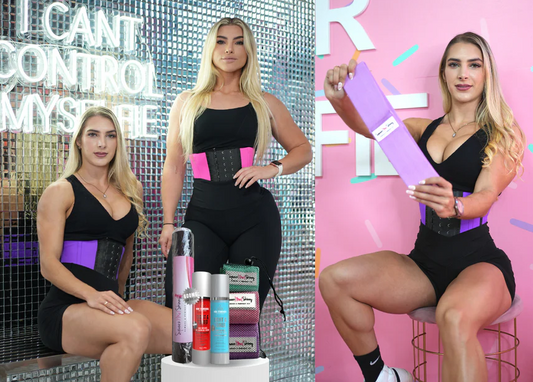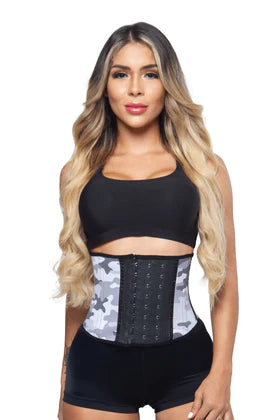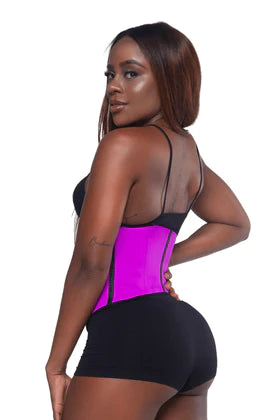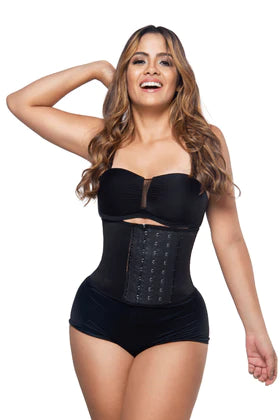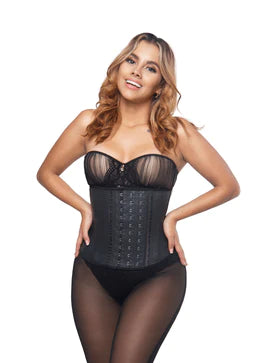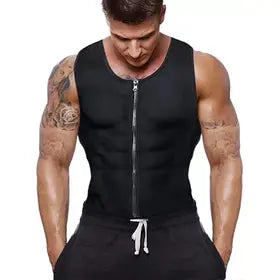
Maximizing your workouts: The ultimate guide to mens waist trainers
If you're looking for an effective way to maximize your workout results, then mens waist trainers are the perfect addition to your fitness routine. A waist trainer is a body-shaping garment that cinches your midsection to create an hourglass figure and to help reduce stomach fat. Wearing a mens waist trainer during exercise can help you stay focused and motivated while also helping to build core strength and create an overall toned appearance. In this guide, we will explore how mens waist trainers can help you get the most out of your workouts.
Why men should consider waist trainers in their fitness routine
If you're a man looking to take your fitness routine to the next level, it's time to consider adding a waist trainer to your workouts. While waist trainers have often been associated with women, they can be just as beneficial for men.
One of the main reasons why men should consider waist trainers is their ability to help trim the midsection and reduce stomach fat. Waist trainers provide compression and support to the core muscles, leading to a more toned appearance. They also promote better posture and help to engage the abdominal muscles during workouts, resulting in improved core strength.
In addition, waist trainers can enhance motivation and focus during exercise. The snug fit of the garment provides a constant reminder to engage the core and maintain proper form, leading to more effective workouts.
Understanding how waist trainers work for men
Waist trainers may seem like a women's fashion trend, but they can actually be highly effective for men as well. Understanding how waist trainers work for men is key to maximizing their benefits in your fitness routine.
Waist trainers work by compressing the midsection, which helps to reduce stomach fat and create a more toned appearance. When you wear a waist trainer during your workouts, the compression stimulates heat and perspiration in the abdominal area, leading to increased sweat and potential water weight loss. This can contribute to a slimmer waistline over time.
In addition to the aesthetic benefits, waist trainers also provide support to the core muscles, which can lead to improved posture and increased engagement of the abdominal muscles during exercises. This can result in enhanced core strength and stability.
Choosing the right waist trainer for your body type and fitness goals
When it comes to choosing the right waist trainer for your body type and fitness goals, it's important to consider a few key factors. First, you'll want to determine the level of compression that is right for you. Some waist trainers offer a higher level of compression, which can be beneficial for individuals looking to cinch their waist more tightly. However, it's essential to choose a waist trainer that feels comfortable and doesn't restrict your movements during exercise.
Next, consider the material and durability of the waist trainer. Look for waist trainers made from high-quality materials that can withstand the intensity of your workouts. Additionally, opt for a waist trainer that is adjustable and allows you to tighten or loosen it as needed.
Lastly, take into account your specific fitness goals. Are you looking to primarily trim your midsection or build core strength? Different waist trainers may offer varying levels of support and shaping, so choose one that aligns with your desired results.
Incorporating a waist trainer into your workout routine
Incorporating a waist trainer into your workout routine is a simple and effective way to maximize your fitness results. Start by wearing the waist trainer during your warm-up exercises to allow your body to adjust to the compression. As you progress in your workout, you can increase the intensity by adding more challenging exercises or increasing the duration of your workouts while wearing the waist trainer. Remember to listen to your body and take breaks when needed.
To ensure proper form, focus on engaging your core muscles and maintaining good posture while wearing the waist trainer. This will not only enhance the effectiveness of your workouts but also help prevent any strain or injury. It's important to remember that a waist trainer should be used as a supplement to your workout routine and not as a replacement for a healthy diet and exercise.
Best exercises to maximize results with a waist trainer
To maximize your results with a waist trainer, it's important to incorporate the right exercises into your fitness routine. While wearing a waist trainer, focus on exercises that target your core muscles and promote overall body toning. Here are some of the best exercises to maximize your results with a waist trainer:
1. Planks: This classic exercise engages your core muscles and helps strengthen your abs, back, and shoulders. With the added compression from the waist trainer, planks become even more effective at sculpting your midsection.
2. Russian twists: This exercise targets your obliques and helps to trim your waistline. Sit on the floor, knees bent, and lean back slightly. Hold a weight or medicine ball and rotate your torso from side to side, touching the weight to the ground on each side.
3. Bicycle crunches: This exercise is great for working your abs and obliques. Lie on your back, knees bent, and hands behind your head. Alternate bringing your left elbow to your right knee and your right elbow to your left knee while keeping your core engaged.
4. Squats: Incorporating squats into your routine helps to engage your core and lower body muscles. With the waist trainer providing support, you can focus on maintaining proper form and enhancing your overall leg strength.
5. Deadlifts: This compound exercise targets multiple muscle groups, including your core and back muscles. With the waist trainer's added compression, deadlifts become more challenging, helping to build overall strength and stability.
Maintaining proper form while wearing a waist trainer
Maintaining proper form while wearing a waist trainer is crucial to ensuring that you get the most out of your workouts while also staying safe. It's important to remember that a waist trainer is not a substitute for good form and technique, but rather a tool to enhance your fitness routine.
To maintain proper form, focus on engaging your core muscles and keeping your spine neutral. The compression from the waist trainer can serve as a reminder to engage your core and maintain good posture throughout your exercises. It's also essential to listen to your body and avoid any movements that cause discomfort or pain.
When performing exercises like squats or deadlifts, be mindful of your alignment and ensure that your knees and hips are properly aligned. Pay attention to your breathing and avoid holding your breath, as this can lead to unnecessary strain.
Balancing diet and exercise with a waist trainer
Achieving your fitness goals isn't just about wearing a waist trainer during your workouts. To truly maximize your results, it's important to balance your diet and exercise routine with the use of a waist trainer. While waist trainers can help create a more toned appearance and assist in reducing stomach fat, they should be seen as a supplement to a healthy lifestyle, rather than a quick fix.
Start by focusing on maintaining a balanced and nutritious diet that supports your fitness goals. Incorporate plenty of fruits, vegetables, lean proteins, and whole grains into your meals, while limiting processed foods and sugary snacks. It's also crucial to stay hydrated and drink enough water throughout the day to support your overall health and wellbeing.
In addition to a healthy diet, continue to prioritize regular exercise and physical activity. Use your waist trainer during your workouts to help engage your core muscles and maintain proper form. However, don't solely rely on the waist trainer for results. Instead, focus on incorporating a variety of exercises, including cardio, strength training, and flexibility exercises, into your routine to promote overall fitness and well-rounded results.
Tips for comfortable and safe use of waist trainers during workouts
To ensure a comfortable and safe experience while using a waist trainer during workouts, here are some essential tips to keep in mind:
1. Start slowly: If you're new to waist trainers, gradually increase the amount of time you wear it during workouts. Begin with shorter durations and gradually increase the length as your body becomes accustomed to the compression.
2. Proper sizing: Choosing the correct size is crucial for comfort and effectiveness. Measure your waist accurately and refer to the sizing chart provided by the manufacturer to select the appropriate size. A waist trainer that is too tight can restrict your movement and cause discomfort, while one that is too loose may not provide the desired level of compression.
3. Hydration: It's essential to stay hydrated during your workouts, especially when wearing a waist trainer. Sweating may be increased, and it's important to replenish fluids regularly to avoid dehydration. Drink plenty of water before, during, and after your workouts.
4. Listen to your body: Pay attention to any signs of discomfort or pain while wearing a waist trainer. If you experience any breathing difficulties or severe discomfort, remove the waist trainer immediately and consult with a healthcare professional if necessary.
5. Warm-up and cool-down: Prioritize warm-up exercises to prepare your body for the workout and cool-down stretches to help prevent muscle soreness and promote flexibility. Incorporating these routines can help optimize the benefits of wearing a waist trainer.
6. Proper breathing: Focus on deep and controlled breathing while wearing a waist trainer. Avoid shallow breaths, as this can restrict oxygen flow and increase the likelihood of discomfort or dizziness.
7. Post-workout care: After your workout, remove the waist trainer and allow your body to cool down naturally. Take a shower and thoroughly dry your waist trainer before storing it in a cool, dry place.
Common misconceptions about men's waist trainers debunked
There are several misconceptions surrounding men's waist trainers that may deter individuals from giving them a try. However, it's important to separate fact from fiction when it comes to waist trainers for men. Here are some common misconceptions debunked:1. "Waist trainers are only for women": While waist trainers have often been associated with women, they can be just as beneficial for men. Men can achieve the same results as women when it comes to trimming the midsection, reducing stomach fat, and improving core strength.
2. "Waist trainers are uncomfortable": When properly fitted and used, waist trainers can be comfortable to wear during workouts. It's essential to choose the correct size and material that suits your comfort level.
3. "Waist trainers are a substitute for diet and exercise": Waist trainers are not a magic solution for weight loss or muscle building. They should be used in conjunction with a balanced diet and regular exercise routine. They enhance the effectiveness of your workouts and provide support but should not be relied upon solely.
Final thoughts on maximizing your workouts with a waist trainer.
In conclusion, incorporating a waist trainer into your fitness routine can be a game-changer for men looking to maximize their workouts. By wearing a waist trainer, you can trim your midsection, reduce stomach fat, and enhance your core strength. With the added compression and support, you'll feel more focused and motivated during your workouts, leading to improved results.Remember to choose the right waist trainer for your body type and fitness goals. Find one that offers the right level of compression, is made from high-quality materials, and is adjustable for your comfort. Incorporate exercises that target your core muscles while wearing the waist trainer to maximize your results.
But keep in mind that a waist trainer is not a substitute for a healthy diet and regular exercise. It should be used as a supplement to your fitness routine. And don't let common misconceptions hold you back. Waist trainers are just as beneficial for men as they are for women.


